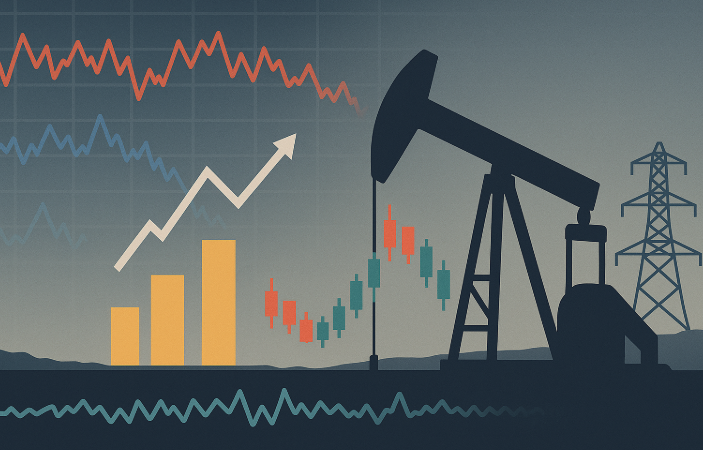Explore Other Resources
Subscribe Today!
How Credit and Capital Markets Could Impact Energy Economics
The U.S. economy has held up well, but financial conditions remain tight. Interest rates have started to ease, yet borrowing is still expensive. That matters for energy. Nearly every part of the system, from power plants and pipelines to storage and transmission, depends on access to affordable capital. When financing becomes harder to obtain or more expensive to secure, energy costs eventually rise.

Infrastructure at the Center
Energy infrastructure is the cornerstone of affordability and reliability. Utilities across the country are racing to build new generation and to upgrade transmission and distribution systems that can handle record electricity demand from data centers, manufacturing growth, and electrification. Natural gas infrastructure is expanding as well, supporting both exports and domestic supply stability.
These projects are large, complex, and heavily dependent on financing. They require years of planning, permitting, and construction. When borrowing costs rise or credit conditions tighten, progress slows. Even small increases in interest rates can delay or reduce investment. Over time, slower infrastructure development tightens supply and raises prices for end users.
Material costs add another challenge. Higher prices for steel, aluminum, and electrical components, sometimes driven by tariffs or trade disputes, make new construction more expensive. Combined with higher financing costs, those pressures can lead utilities to scale back or postpone projects that are vital for long-term reliability.
Credit, Capital, and Energy Costs
Credit and capital markets shape every link in the energy value chain. When rates are high, building new pipelines, LNG terminals, and renewable projects becomes more expensive. Utilities must pass those expenses through to customers to recover their investments.
Earlier this week, the Federal Reserve reduced its benchmark rate by a quarter point, a small but notable shift that slightly eases financing pressures across capital-intensive sectors like energy. However, several indicators suggest that broader economic momentum may slow in the months ahead, potentially tempering future rate cuts or new investment.
If credit remains available but expensive, large and well-capitalized firms can keep building, while smaller developers often find it harder to move projects forward. The result is slower innovation and a reduced pace of energy development across the sector.
When credit conditions improve and interest rates fall, financing becomes more accessible. That allows more projects to move forward, increases competition, and helps moderate long-term energy costs.
The Role of Policy and Trade
Trade policy also affects the cost of building and maintaining the energy system, though its impact is smaller than that of credit conditions. Tariffs on materials like steel and aluminum raise the price of components used in power lines, turbines, and pipelines. While these increases may seem minor in isolation, they accumulate quickly across large-scale projects. For developers already facing higher borrowing costs, the added expense can delay or scale back projects.
Stable, predictable trade and financial policies make it easier to plan investments that support both reliability and affordability.
If the Economy Weakens Sharply
If the economy were to weaken significantly, the effects on energy would likely unfold in two stages.
In the short term, a slowdown in industrial activity and lower consumer spending would reduce energy demand. Oil, gas, and power prices could fall temporarily. Credit markets would probably tighten further as investors seek safer assets, creating additional headwinds for infrastructure investment. Projects already under construction might continue, but new ones would likely pause.
Over a longer period, reduced investment would limit supply growth and delay maintenance on existing assets. When the economy eventually recovers, demand for energy would rise faster than capacity, leading to higher prices and potential reliability challenges. Regions already facing grid constraints or limited pipeline capacity would face the earliest and most significant impacts.
In energy markets, economic shocks often unfold in two stages, with prices dipping as demand falls and then rebounding as supply lags the recovery.
What This Means for End Users
For end users, the effects of capital and credit conditions appear slowly but persistently. Energy bills rise not only because of fuel costs but also because of the expense of financing and building the systems that deliver energy.
In high-growth regions such as Texas and PJM, electricity rates may continue to climb as utilities invest heavily in new generation and transmission. Natural gas prices should remain moderate under current conditions, but if infrastructure build-out slows, the balance could tighten, especially as LNG exports continue to grow.
Reliable, affordable energy depends as much on financial stability as on fuel supply. When borrowing becomes harder or more expensive, the effects ripple through the entire system. Energy prices are no longer dictated solely by oil or natural gas. They are increasingly shaped by credit markets, capital availability, and construction costs.
A stable financial environment allows utilities and developers to build infrastructure that keeps prices steady and the lights on. Tight credit, high interest rates, and unpredictable policy make that work harder and more costly. The future cost of energy will depend not just on what we can produce, but on what we can afford to build.
For additional information please contact us to schedule a quick call.
